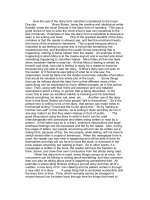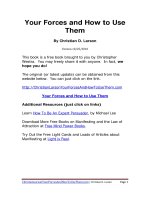Pragmatics, how people use language
Bạn đang xem bản rút gọn của tài liệu. Xem và tải ngay bản đầy đủ của tài liệu tại đây (427.72 KB, 2 trang )
Pragmatics: How People Use Language
Zainurrahman (Under guidance of Prof. E. Aminudin Azis, M.A., PhD.)
STKIP KIE RAHA TERNATE-INDONESIA
|
ZPJ: Free Access Journal of the Philosophy of Language and Education (2010)
Language in use is about how
language is used by the speaker and perceived
by the hearer. Talking about language in use is
talking about Pragmatics. Pragmatics is one of
the items in the trichotomy of general science
of signs (read: Semiotics). The trichotomy, by
Charles Sanders Peirce is syntactic-semanticsand pragmatics.
When the sentence is restructured
become Donut ate John, the connections
become illogical. The meaning of Donut is
food, and it is impossible that a kind of food
eats human. Here, it can be seen that the
difference between syntax and semantics is
that if syntax is about the structure without
meaning, semantics studies the structure and
the meaningfulness of signs connection.
Therefore, syntactically the restructured
sentence is meaningless or unacceptable.
Syntax is about words connection; the
connection of grammatical structure of
sentence, the form of sentence. Syntax studies
the connection among signs without
considering the meaning of signs, the specific
signification, and the function of relation
among signs.
Nevertheless, sometimes we may find
that kind of sentence (Donut ate John). It may
have meaning like: Donut is actually a name of
monster. The sentence may be used in certain
context for certain purpose. Here, pragmatics
plays its role.
Example:
John ate donut
Pragmatics concerns signs as well, but
it is more about how those signs are used and
interpreted. How do people produce, offer, and
interpreted language. The sentence given may
be used as a joke, insult, and so on.
The sentence above is meaningful in a
perfect grammatical structure. Syntactically,
although the sentence is restructured become:
Donut ate john
Pragmatics is concerned with the
study of meaning as communicated by a
speaker (or writer) and interpreted by the
hearer (or reader). Therefore, pragmatics is the
study of the speaker meaning, in certain
context. What meant with context is whom
they are talking to, where, when, and under
what. Pragmatics also studies how more gets
communicated than is said. Pragmatically, we
cannot understand the sentence “Donut ate
John” literally, but we should look deeper,
what the speaker’s meaning is. Pragmatics is
The sentence is syntactically correct.
The connections of signs are true. However, is
it possible that donut can eat John?
Semantically, the second sentence is
illogic. Semantics is about the meaning of the
signs connection. John and ate is correctly
connected, donut as the object is required
because verb ate is transitive verb. John
function as the actor who performs ate and
donut as the patient that is the verb ate
performed on. The connections among entities
in the sentences are logic.
1
also the study of the expression of relative
distance, or the relationship of interactants.
People expressions are different each
other, or people express their meaning for one
differently to other. For the example, you can
say “Open the door!” to your friend, your
younger brother or sister, but you cannot say it
to your lecturer that way. To do that
expression, you may use more polite utterance
“May the door is opened?” or “It is very hot
here” or other way. What makes you do this is
the difference of relative distance.
It is clear that pragmatics is about how
people use language in certain context for
certain purpose. In pragmatics, we will find
some tools to be used to analyze the speaker
meaning, or the meaning of utterance in
context.
2









